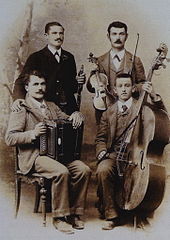Paul Kollegger
Paul Kollegger (born November 21, 1872 Vaz / Obervaz , † March 27, 1927 there ) was a clarinetist from the Swiss canton of Graubünden . He was the founder of the Kollegger musician dynasty and is considered one of the ancestors of Graubünden folk music.
Life
Paul Kollegger grew up as the son of the worker Hilarius Kollegger on Lenzerheide . At first he worked in the area and in France as a forest worker and lumberjack, but played as a clarinetist from an early age.
From 1895 to 1905 Kollegger worked as a postillon on the Churwalden - Tiefencastel route . He did not play with a fixed formation, but instead recruited his playing partners spontaneously at the location of the event. He mostly played in a formation of four with a clarinet, two violins and a double bass. Brother Johann played bass, brother Luzi the violin. Some compositions by him have also survived. Kollegger's ancestors were also musically inclined, so Paul's mother played the double bass in the "Kollegger" band from time to time. Lenzerheide / Lai, Valbella and Parpan are probably the main venues for the band.
Paul Kollegger later taught his nephew Anton to play the clarinet and took him to the performances as the second clarinetist. They were now also accompanied by a hand organ or a Schwyzerörgeli . Kollegger himself played the C or A clarinet. A Paul Kollegger clarinet is still in the family's possession; it was once exhibited on loan in the Rhaetian Museum in Chur.
Kollegger could neither read nor write music and understood nothing about music theory. Nevertheless, he had a repertoire of around 300 pieces - including pieces of Bavarian and Austrian origin - and could easily play a night without repeating a piece. A free night usually began on a Saturday at 2 p.m. and often only ended at 8 a.m. before going to church.
In 1910 he became a goatherd in Trins . During this activity he injured his left thumb, which led to the amputation of the front phalanx. Kollegger remedied this disadvantage by holding the clarinet at an angle to his mouth.
Paul Kollegger, described as taciturn, friendly and serious, died in Lenzerheide-Valbella within a few days of the consequences of pneumonia, from which he fell ill in early spring 1927. He was buried in Zorten . The grave no longer exists.
Since Kollegger could neither read nor write notes, many of his original dances from oral tradition were published under other names in later years or are now considered traditional compositions. Some of his dances and pieces were handed down "orally" and later noted down.
Paul Kollegger had a son from his first marriage who died one day later. His second marriage was childless. His sister had seven children, including twins (two boys), who were raised by Paul Kollegger and his wife. One of them, Anton, he also trained as a clarinetist.
Web links
- Andy Kollegger (PDF; 2.4 MB)
Individual evidence
| personal data | |
|---|---|
| SURNAME | Colleague, Paul |
| BRIEF DESCRIPTION | Swiss clarinetist and composer |
| DATE OF BIRTH | November 21, 1872 |
| PLACE OF BIRTH | Vaz / Obervaz |
| DATE OF DEATH | March 27, 1927 |
| Place of death | Vaz / Obervaz |


